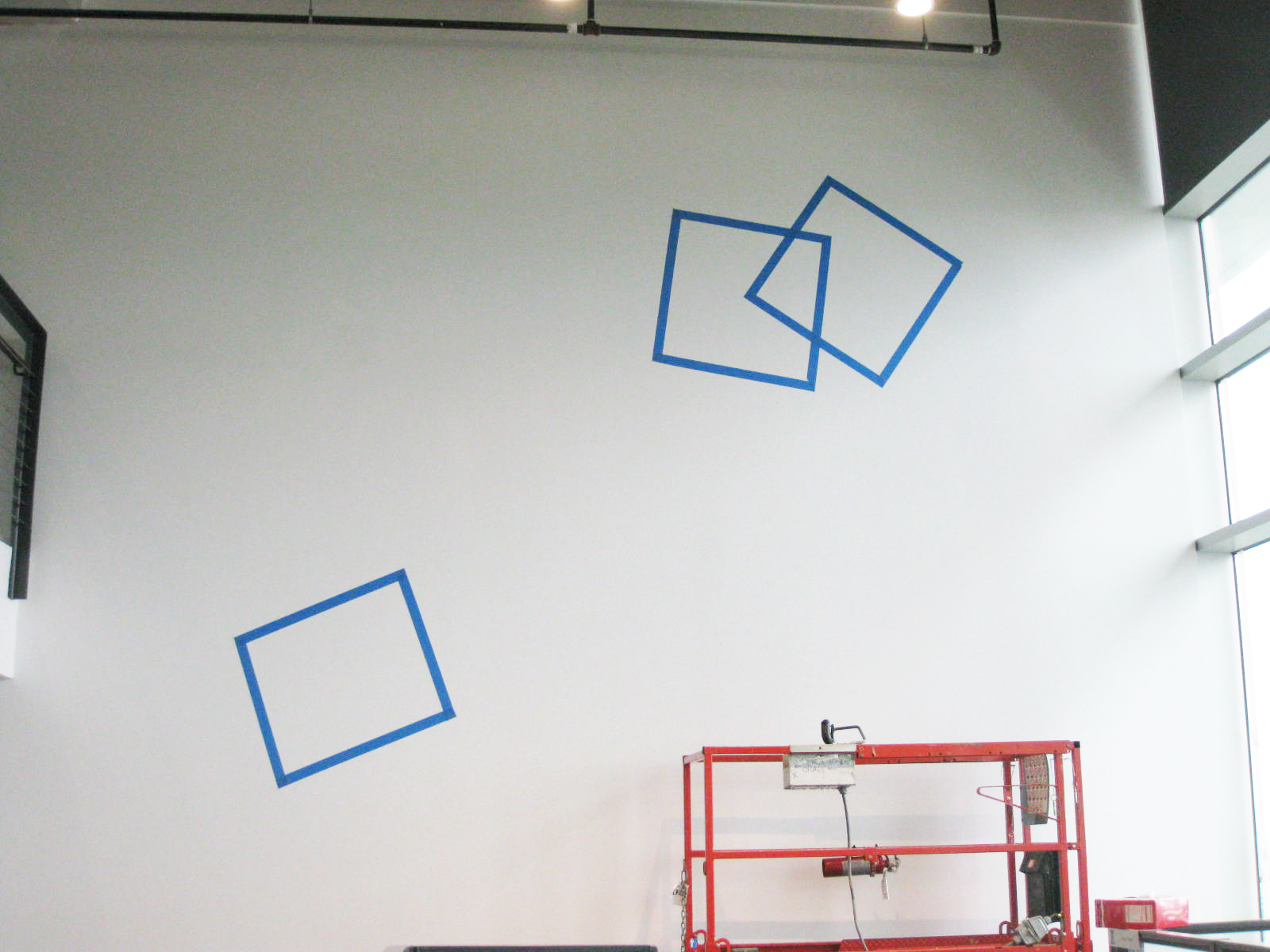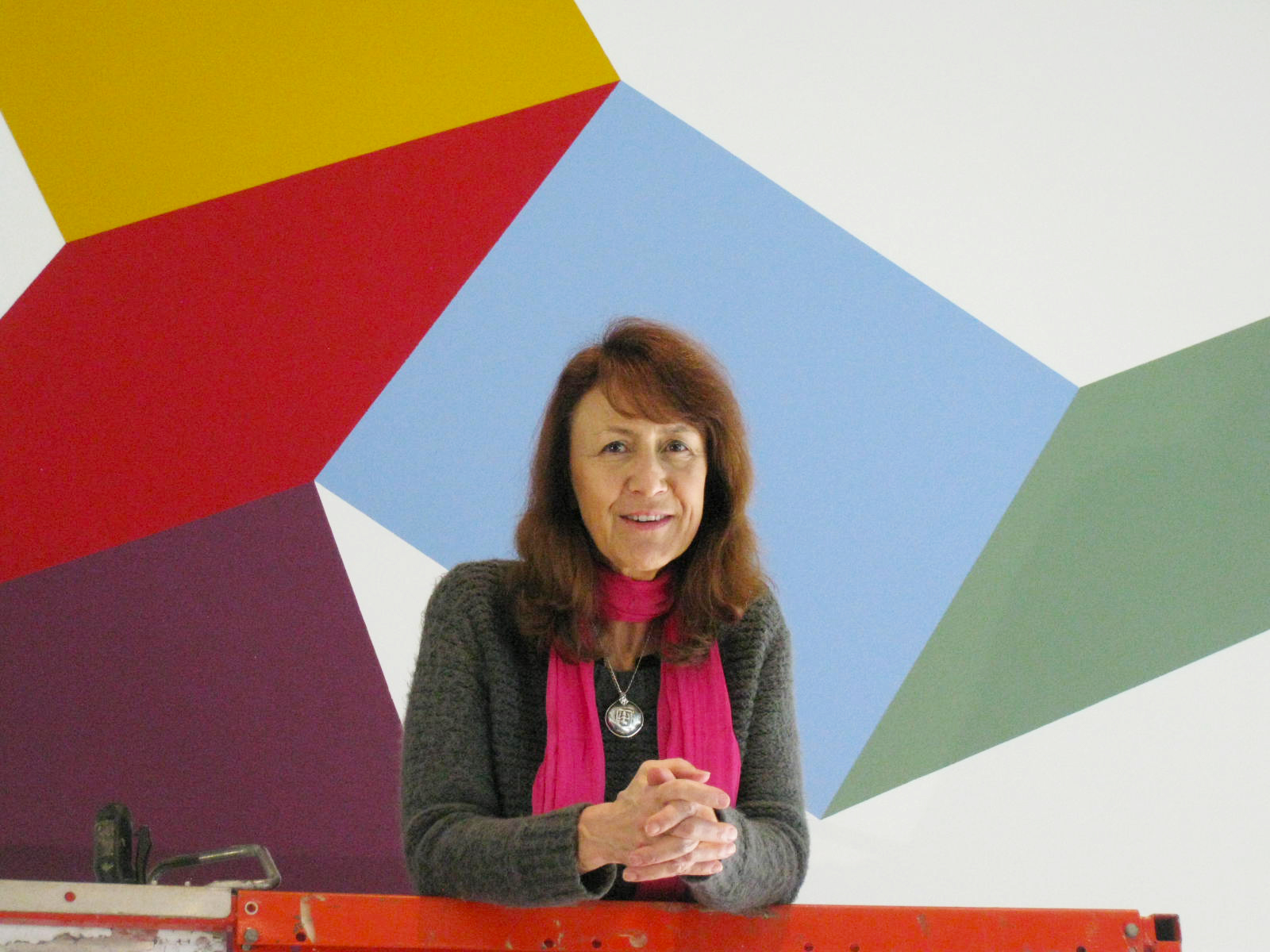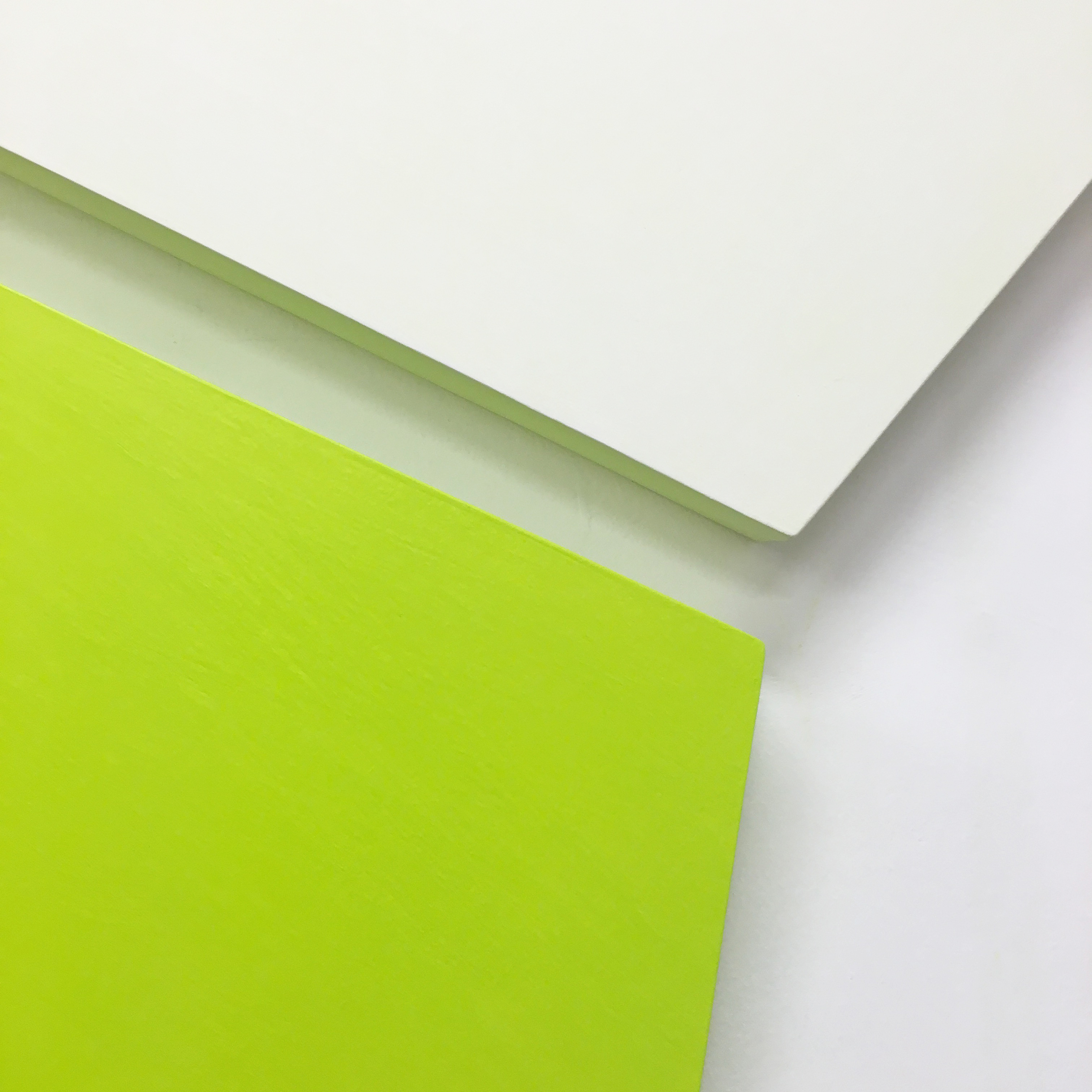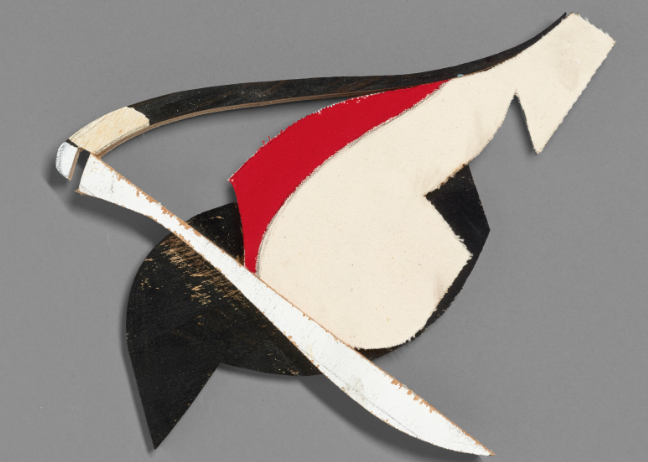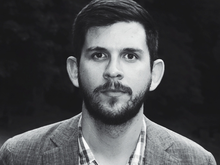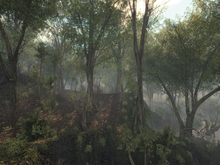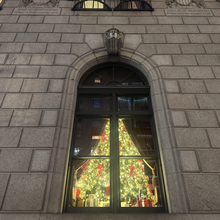VISIT US IN NEW YORK!
KAC has boots on the ground in the big apple! Bet you didn’t know that our very own, Kimberly Landa has been operating in New York for almost two years covering projects for Kinzelman Art Consulting? We thought it would be fun to catch up with her about officing in the city, navigating NY during COVID and how she’s managing to access incredible art for our clients.

Kimberly @ Perrotin Gallery Gift Shop
Q&A:
Q: You relocated to NYC prior to the pandemic, how has your experience in the city changed during this time and how do you manage to keep work going?
A: Watching the pandemic work its way through the city was a wild experience. Witnessing nightly 7pm applause, a dead empty Broadway Street, protests and riots, then boarded up windows covered in fresh street art made me appreciate the resilience of New Yorkers. Despite the circumstances, it was cool to experience the city in a different, quieter way without the buzz of my busy schedule. Now it feels like NY is getting its groove back, and as hard as some days were, I think I’ve earned some street cred by toughing out the majority of 2020 here!
The key to my tiny apartment-office lifestyle is spending as much time as possible outside, even if it’s for 10 minutes to drink my coffee or between calls. Also, infusing life into my space with my tiny art collection makes my “home office” way more bearable. Lastly, I make a conscious effort to move around my apartment frequently to change it up. Big things happen for KAC when I move from my kitchen table to the couch!
Bloomingdales windows mid-pandemic
Q: Now that galleries and museums are slowly opening, accessing art exhibitions first hand must be a welcome respite. How are you feeling about seeing art in person again after being separated from the gallery scene for so long?
A: I swear I didn't feel human again until I reentered The Whitney last month! Previously, my weeks were packed with openings and gallery appointments. There was never a dull moment and my mental art inventory and iPhone camera roll were always growing at an exponential rate. When the world screeched to a halt in March it was definitely a transition.
I recently attended Tribeca art night and saw a handful of shows in Chelsea. Now I’m far less concerned with my schedule, and spend more time engaging in conversation and really being present with the work. I used to try to pack it all in, and now I am okay with seeing less in a day but having a more meaningful experience. It's hard to top the convenience of speed dating with artwork via online viewing rooms in my slippers, but I really missed the human element, and the irreplaceable experience of stepping into a bright airy gallery and having an instinctual first reaction to a show.
Kimberly at Alex Dodge exhibition at Klaus Gallery, LES
Q: How has living in NY shaped the way you service our projects?
A: I like to say I used to have a long distance relationship with the NY art scene, and now I do with our Texas-based clients. Aside from the obvious answer that I live in the center of endless art opportunities for our projects, moving here pre-pandemic definitely gave me a jump start to working remotely and relying on technology and zoom to manage projects, a way of working we didn’t know would soon be universal!
Q: Can you describe a project that has directly benefitted from you being in NY?
A: Recently, a client of ours had trouble deciding between two artworks that were at a show in Chelsea. It was so convenient (and fun) to have the luxury of hopping over to the gallery in minute's notice to study them further and help our client make a final call. I sent videos in the space to our client so she could understand the scale and texture better, then we had a discussion while I was at the show to make a quick decision based on my first hand experience with both artworks. A decision that can take numerous phone calls and email exchanges was made in just a few minutes, and enriched my work day! We also have a handful of clients with global collections, which result in much easier management of the the New York collections now that I am here and ready to go when something comes up.
Film Forum in Chelsea, mid-pandemic
Q: Got any funny or peculiar stories about life in NY?
A: There are so many I could truly write a book. I tend to be a magnet for peculiar stories, which is only amplified living in the ultimate city of unpredictability. Most recently, I had to hire a “couch surgeon” in order to fit my beloved pink couch into my new apartment because the entrance to my building was too narrow. I drove his car around so he could avoid parking expenses while he deconstructed my poor couch on the sidewalk to it’s bare bones, and completely rebuilt it inside of my living room within an hour. I've since learned that couch surgeons are not uncommon here.
The real kicker was the close proximity of my building entrance to the neighboring, very nice restaurant. I’m sure it really glorified the NYC outdoor dining experience to enjoy a lovely sushi meal alongside an invasive couch surgery!

Kimbelry at Donald Judd show, MoMa
In KAC’s latest Interview, Houston-based painter and professor Bradley Kerl shares an inside look into what originally focused his creative journey towards painting, where his body of work is headed and exciting news about his growing family.

Kerl's work at Texas Contemporary Art Fair, 2016.

Kerl's site-specific still life set at Gensler, Houston.
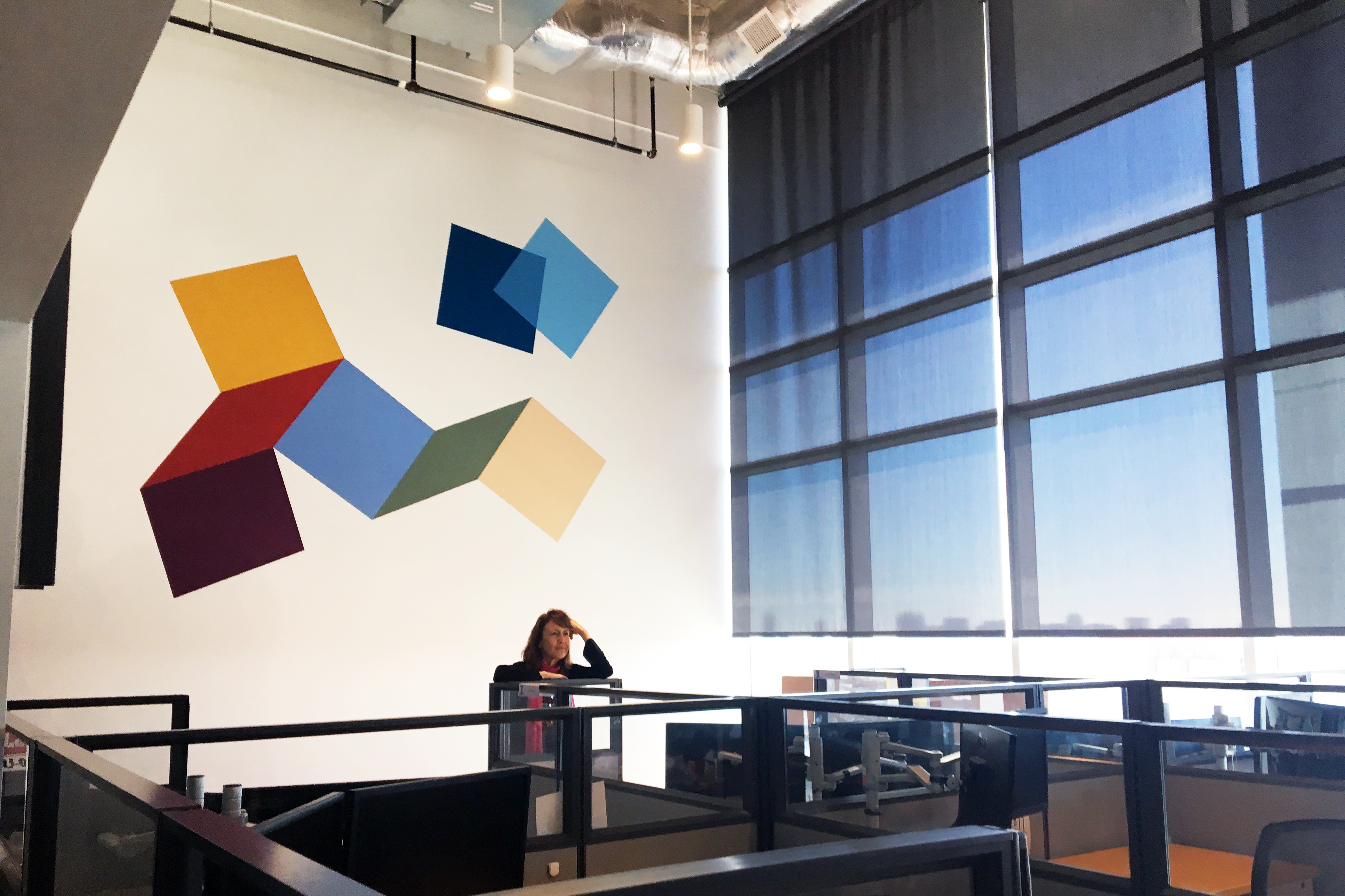
Mokha Laget, "Southern Wing"
Kinzelman Art Consulting is celebrating the completion of a two-story geometrical wall mural, Color Field, commissioned by artist Mokha Laget, represented locally with Gallery Sonja Roesch. Although Laget was undoubtedly influenced by her time as Gene Davis’s studio assistant, her work is deeply rooted in her own distinct exploration of color composition and shape precision. KAC took advantage of Laget’s four day Houston visit to discuss her artistic process, cultural influences and life balance.
KAC: The painting commissioned for Johnson Law Group is part of a larger body of work. What was the catalyst for this series of forms and have they always been a part of your visual dialogue?
ML: The image for this commission originated from several drawings based on mosaics. The idea was to scale up the tessellation to a monumental scale for the architectural space. Last year I took a trip to Morocco and stopped in the historical ruins of an old Roman town. 2000 years later the mosaics were virtually intact, and the geometry is still universal. I made a series of works based on those patterns but exploded the rigid predictability so that the motifs began floating in space. I then integrated the idea of perceptual ambiguity so that depending on where you stand, the elements of the piece appear at once to come forward or recede to invisible vanishing points. Much of my work plays on perceptual ambiguity.
Mapping out "Southern Wing", credit: Mokha Laget
KAC: This painting is much more complex than meets the eye and the completed work will be the result of multiple steps and extreme attention to detail. Will you please describe the process that goes into a wall painting like this?
ML: As with all of my paintings, the preparation sketch is a small pencil drawing on graph paper. From these I select a specific configuration to further develop. Color, however, is never planned in advance. In the case of a mural, I create a more detailed sketch and envision several color schemes that can change at the last minute. For this project, I wrote software code to create a computer representation and refine the color selection. I work with an engineer who takes my program and generates what looks like pages of numbers but is actually a series of mathematical equations to generate coordinates that allow us to modify or laser plot the image in the correct scale onsite.
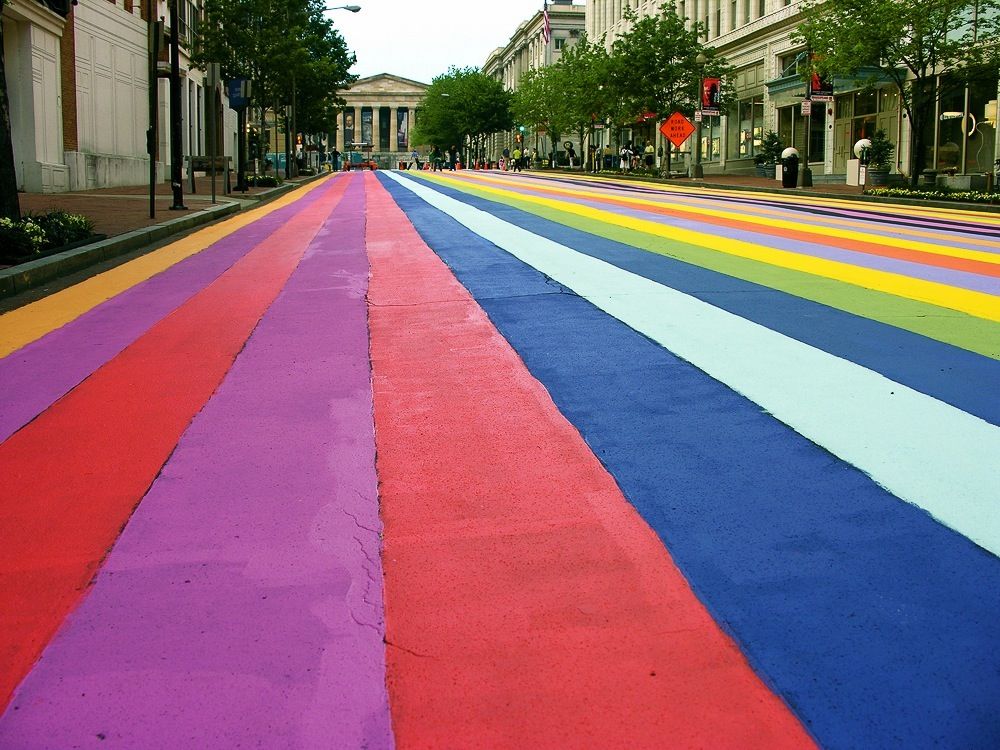
Mokha Laget, "Gene's Jubilee" on 8th St. NW in Washington DC, credit: Mokha Laget
KAC: What is the largest painting you've completed to date?
ML: In 2007 I was commissioned by the Washington DC Commission on the Arts and Humanities to create a 450’ x 50’ street painting on 8th St NW. It was part of a citywide Color School revival. I called it Gene’s Jubilee as a nod to Gene Davis, a Washington Color School painter. I worked as his studio assistant for 4 years and when he died suddenly, I was asked to design the first street painting below the National Museum of American Art where his memorial exhibition was. That was in 1987 then I reprised a different color scheme for the 2007 painting. You had to be on a rooftop or in a helicopter to see the whole thing.
Work in progress of "Sourthn Wing", credit: Bill Dolson
KAC: You've stated that you gather creative material from your travels. Are you gathering ethereal data such as light, awareness and emotion or physical data like architectural shapes and design form and color? How do you document your discoveries?
ML: I have moved around my whole life. Travel is lifeblood; it connects the planet. Humans are not so different worldwide but their cultures and creations are. Every place I visit gives me ideas, whether it is an exotic land or my own back yard. I try to note them in my notebook every morning. They become a kind of library to draw from. I may be interested in the obscure historical use of red in India vs. Japan, or the plain shadows cast on a corrugated shelter in Africa. Light sources are tremendously important in my work, going back to my early years growing up near the Sahara. Ultimately what I paint is the sense of place, real or imagined.
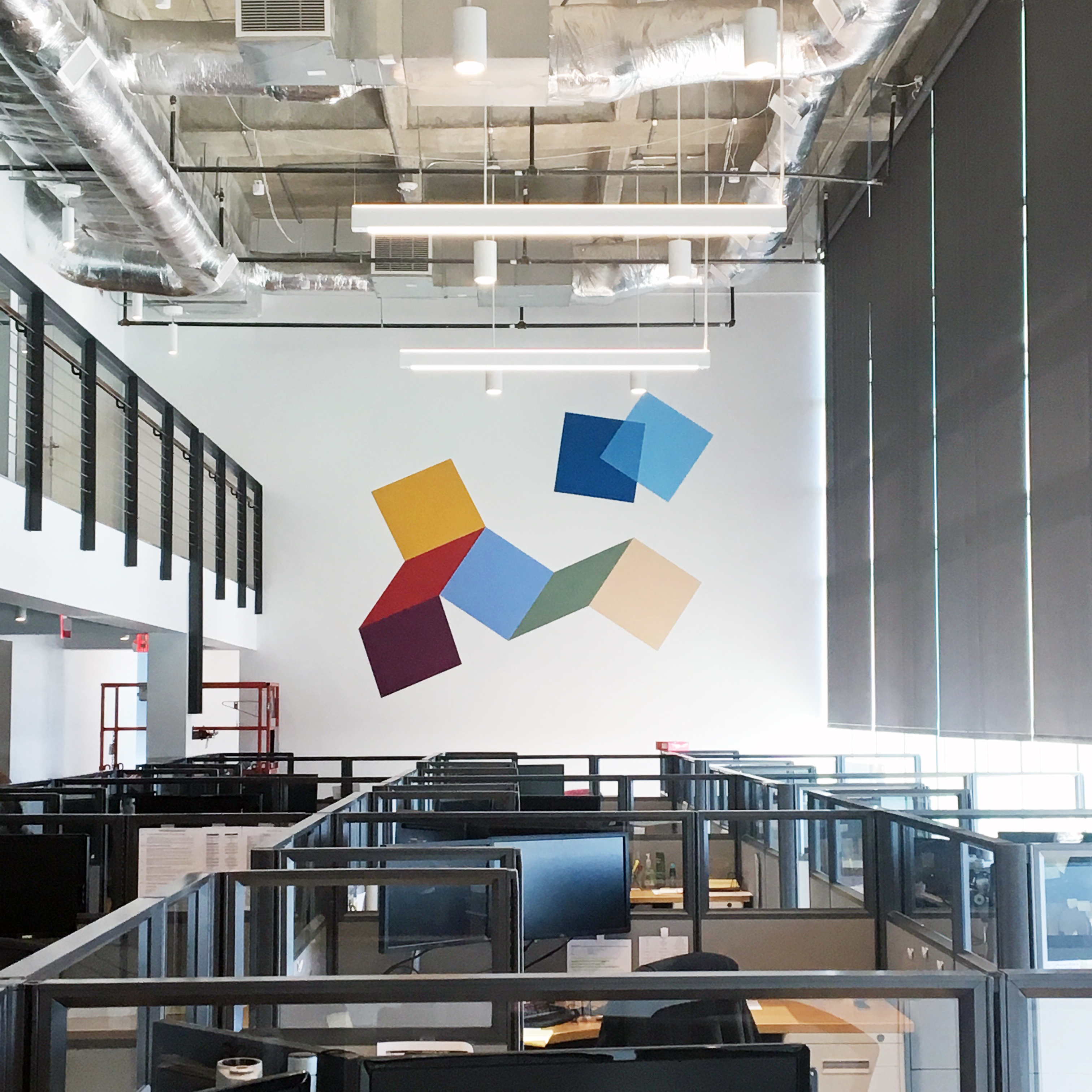
Mokha Laget, "Southern Wing"
KAC: Will you speak to how your secondary role as a simultaneous French interpreter informs your work and provides balance in your life as an artist?
ML: I’ve been fortunate to have a skill, which allowed me to work as another kind of bridge builder around the world. As a simultaneous interpreter, I am engaged in quasi performance art. In art you often work alone but in language you are compelled to interact with the world and those in it. I greatly value my privacy as an artist, but I never wanted to spend my life in studio isolation. It’s important to live in your time, experience it, and strive to understand it.
KAC: What might we find in the corner of your studio?
ML: …Old maritime and aviation maps, Franco-Prussian war manuscripts, a yellow toy Citroen DS, a rusted civil war canon ball…
Mokha Laget is represented in Houston, Texas by Gallery Sonja Roesch and in Santa Fe, New Mexico by Peyton Wright Gallery.
Portland based artist Elizabeth Atterbury talks art, inspiration, and the transition of being a new mother with KAC in our latest Interview Interview.


Elizabeth Atterbury, "Happy Sunny Jade" 2016, installation view

Elizabeth Atterbury, "Relief (Studio Taupe)," 2015, MDF, paint
Myke Venable's work investigates the infinite potential and purity in shape indicating a visual representation of his own paired-down universe. From detailed sketches in an open notebook on the worktable to mathematical drawings tacked to the wall, Venable's studio is a perfect diagram of his working and theoretical process. During our visit, KAC viewed Venable's newest body of work and saw how his paintings have evolved into what they are today.
Door to Myke Venable's studio space
While teaching at The Art League in Houston, Venable rediscovered his love of drawing. He has since dedicated one of the largest walls in his small studio to colorful geometric explorations, mapping out on paper his ongoing study of the complex relationship between shape and color. While he views his drawings as independent works, they also serve as inspiration for shaping his large canvas and panel paintings.

Venable with his geometric studies on paper
The drawings come to life on wood panels covered with pristine layers of acrylic paint squeezed straight from the tube. Mixing colors, he explains, would complicate his process of instinctually matching color and shape. Venable then focuses on creating thought provoking relationships through the particular arrangement of each element on the wall.

Cluster of Venable's paintings in his studio
Venable’s newest paintings cleverly juxtapose not quite symmetrical shapes with slightly irregular placements and parings. Tension builds within the negative space between the paintings as they barely touch, leaving the viewer to question whether the forms are merging together, floating apart or statically coexisting. Every combination creates a new dynamic that alters the energy of the cluster itself, therefore impacting the space in which it resides.
Looking ahead, Myke seeks to push boundaries of depth, scale and color. Myke Venable is represented in Houston by Gallery Sonja Roesch where his next exhibition opens on January 21, 2017.
California based artist Klea McKenna walks KAC through the evolution of her first beginner photography class to her ongoing experimentation with photograms. Read our interview below to learn how McKenna continuously pushes the boundaries of traditional photography practices, producing an innovative body of work.


Klea McKenna, "Archipelago," 2012-2013, photogram

Klea McKenna, "Rainstorm & Rain Studies," 2013-2016, gelatin silver photogram
McKenna is represented in Los Angeles, California by Von Lintel Gallery.
Hidden at the end of a beautiful lot densely populated by lush Houston greenery, Libbie Masterson's studio feels like her own personal oasis. The high ceilings and large windows yield a flood of soft natural light ideal for viewing her vast array of work including photographs, paintings, watercolors, glass mosaics and even stage set maquettes.
Masterson's lively persona is a striking counterpart to her tranquil, contemplative work. Our studio visit began with a look at her new glass mosaics, an extended exploration of her large-scale installation at the Houston Hobby Airport. These works are heavily influenced not only by Masterson's affinity for nature, but also music. Masterson shared her life-long fantasy of composing a symphony, and explained to KAC how she incorporates this hidden passion into her work by listening to songs on repeat and allowing the music to dictate the emotional direction of each mosaic.

Close up of Masterson's glass mosaics
The imaginative glass compositions provide a splash of color to Masterson's otherwise monochromatic studio, filled with icy landscape photographs of deep grays, blues, and whites. These mesmerizing and meditative photos are back-lit and displayed as illuminated light boxes. Masterson walked us through the rewarding process of working with the light boxes, and calculating the perfect hue and strength of light to properly enhance the imagery without overpowering it.

Masterson's light box photographs
Masterson’s dream project: set design for an entire opera! Her infinite sources of inspiration and matching talent pose a promising future of endless possibilities and exploration. Be sure to attend her upcoming exhibition, opening September 10th 2016 at Catherine Couturier Gallery, who represents Masterson in Houston.
Former Director of Affiliates for the Solomon R. Guggenheim Museum in New York, Alison Weaver, walks KAC through the exciting transition into her current position as Executive Director at Rice University's Moody Center for the Arts. Check out our interview below to get the details on Weaver's return to the Houston art community!

Don't miss Rice University's new Moody Center for the Arts, opening to the public in February of 2017.

Rendering of the new Moody Center for the Arts
KAC asked Curator of The Menil Collection, Michelle White for an inside look into her daily life and points of inspiration. See what this Houston art community power house has to say.

Inside of The Menil Collection

Texas based artist, Michael Kennaugh, talks art with KAC. In this exclusive interview Kennaugh describes his experience in the growing Houston art scene and the colorful inspiration behind his process. He also reveals a glimpse into his forthcoming body of work.

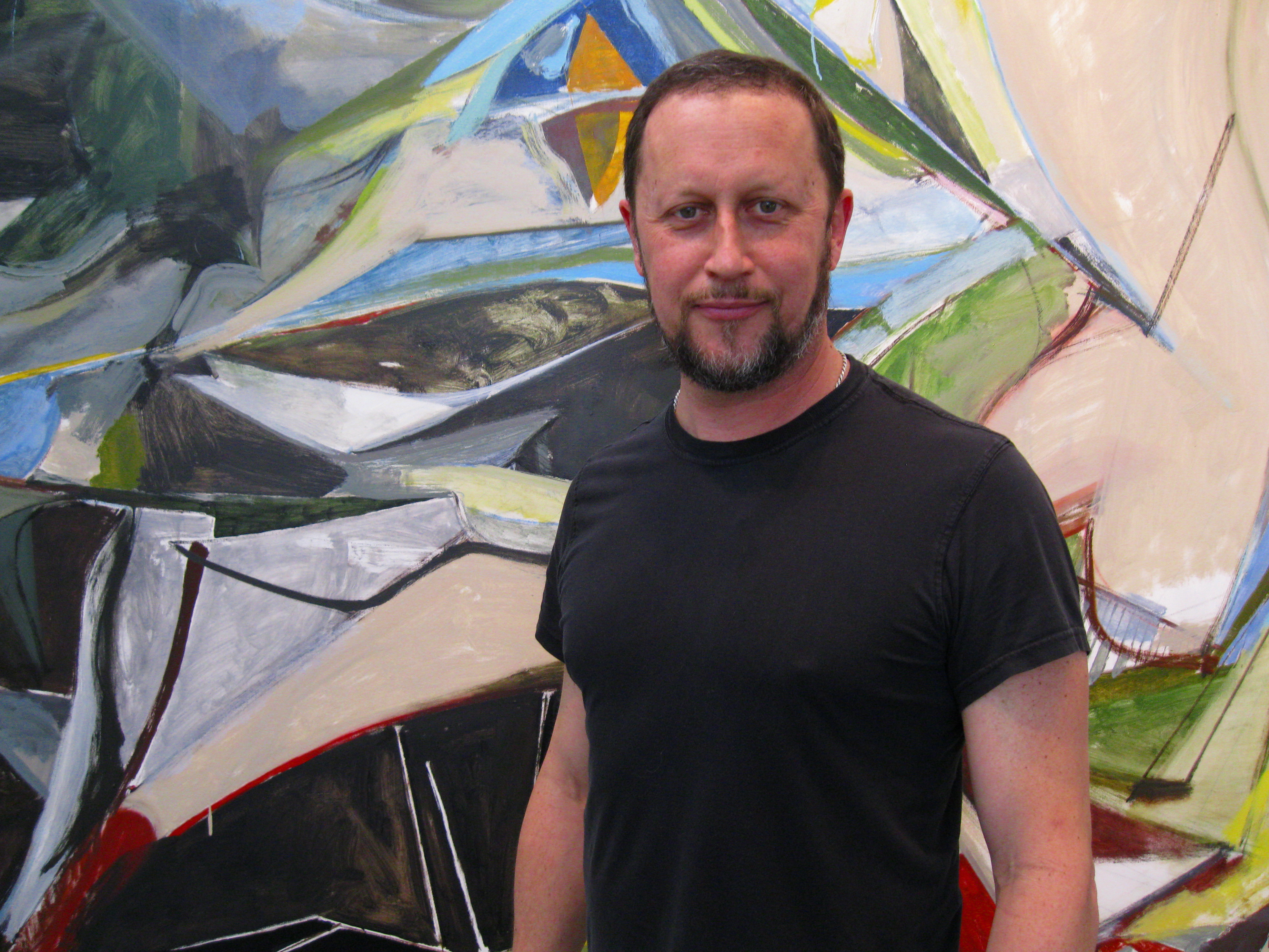
Michael Kennaugh, artist
Founder and Director of bitforms gallery, Steve Sacks, gives us the inside scoop on his quirky upbringing, his futuristic gallery, and his twenty-first century go-to technological tool in this exlusive interview with KAC.

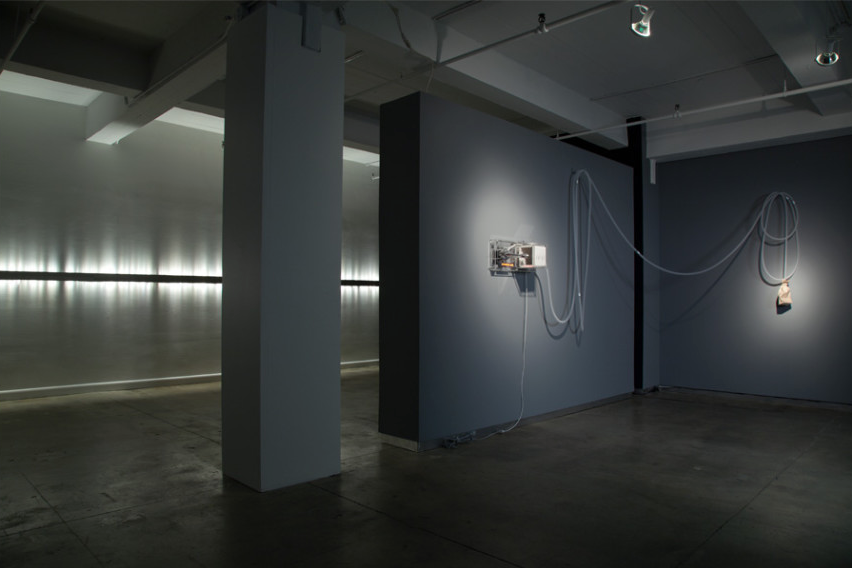
Inside view of bitforms gallery
KAC got together with Rainey Knudson for an exclusive interview discussing the forthcoming April 30th OFF ROAD event with William Wegman. Here is what Founder and Publisher of the Texas arts online magazine, Glasstire, has to say.
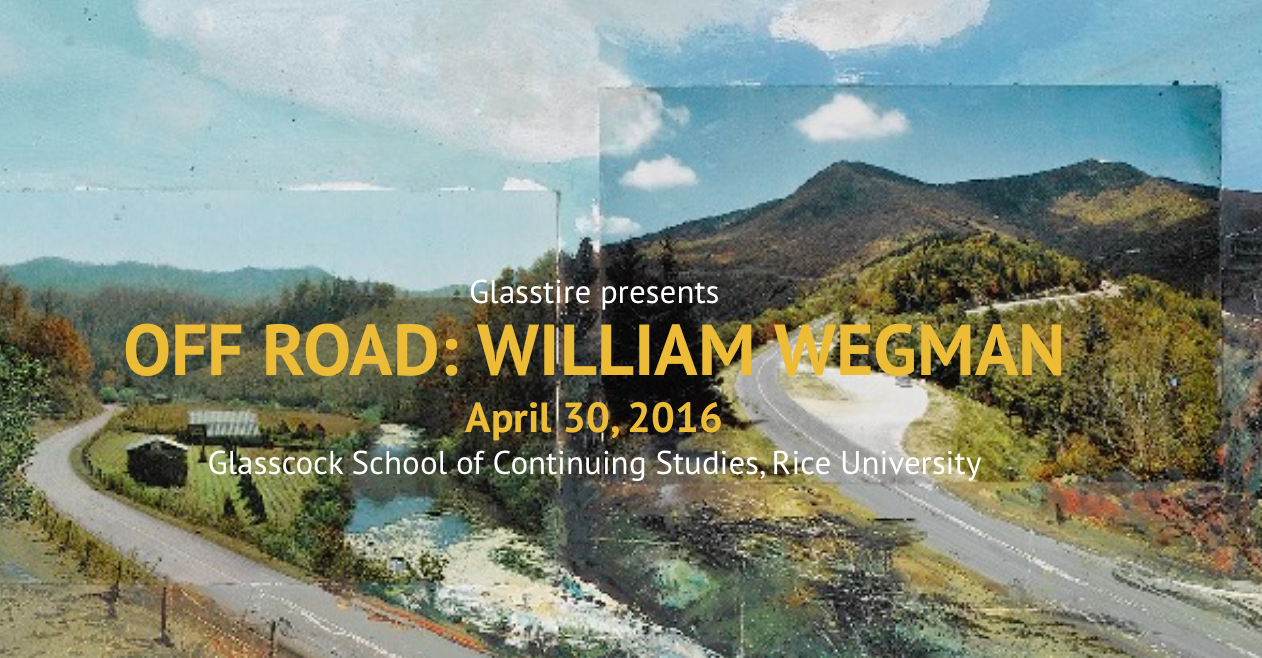
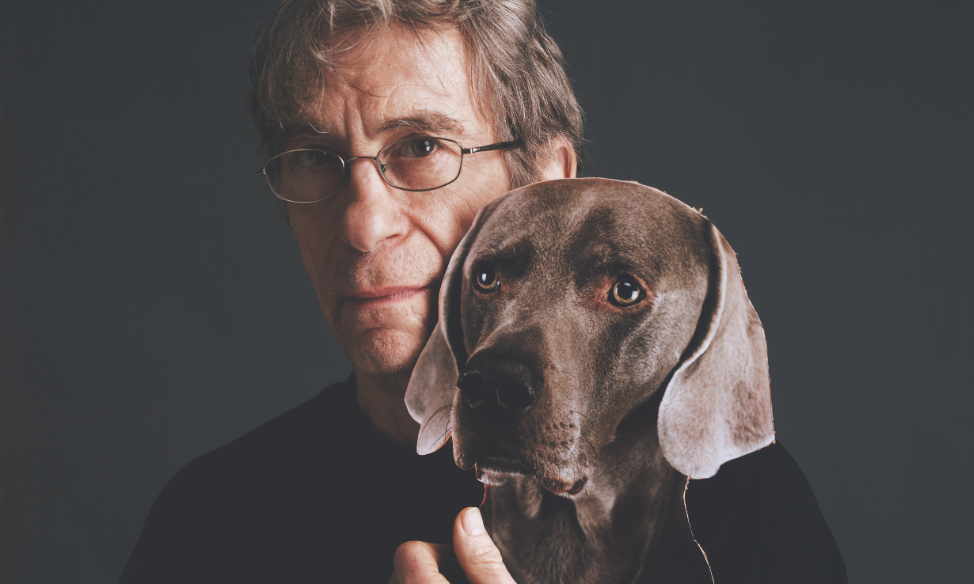
William Wegman, speaker at OFF ROAD 2016

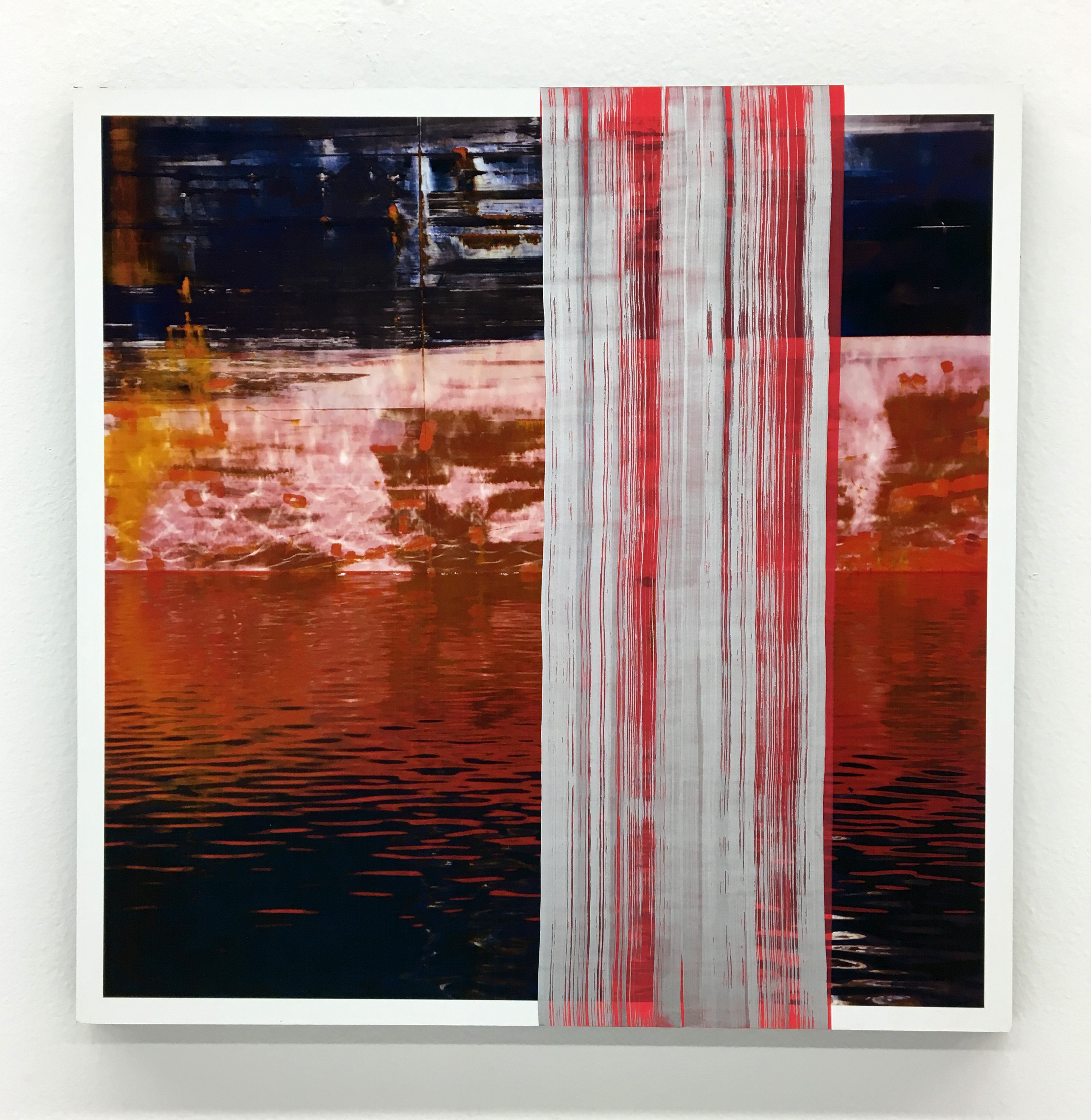
Casey Williams, Untitled, c.2012, acrylic on archival inkjet print. Exhibited at Art Palace Gallery. 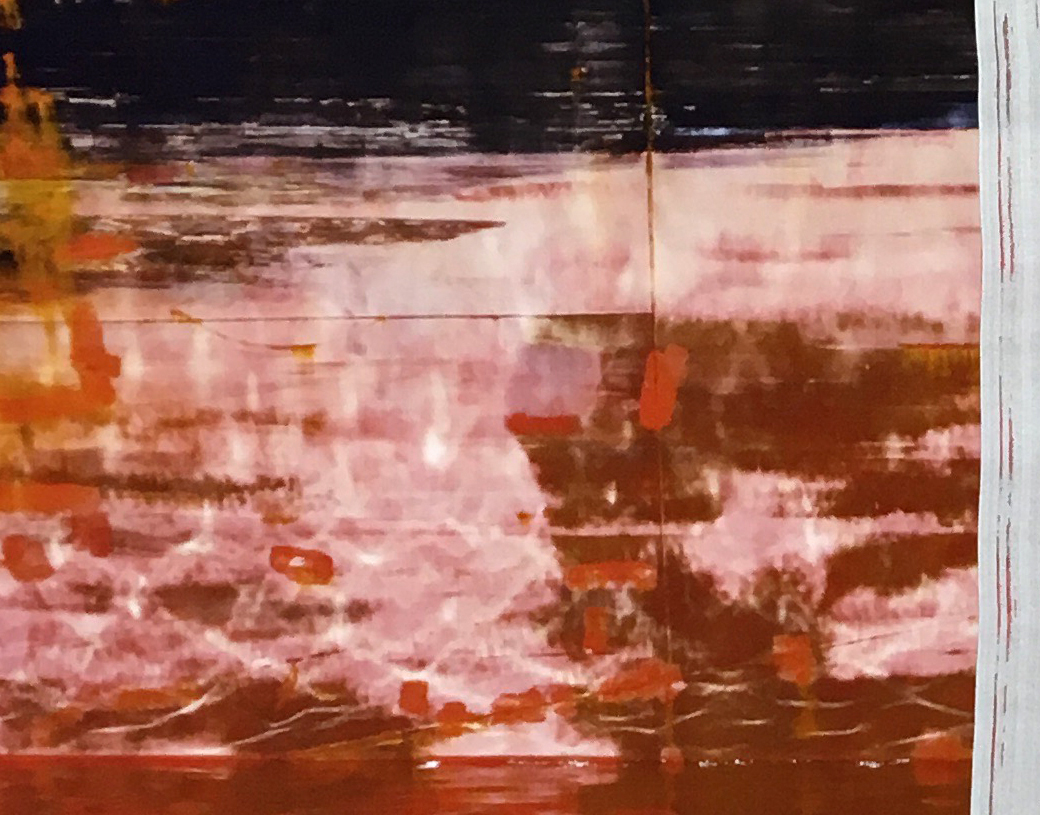
Casey Williams, Untitled (detail), c.2012, acrylic on archival inkjet print. Exhibited at Art Palace Gallery.
As a long time friend of Casey Williams we were delighted when Art Palace put on an exquisite show of never before seen works by Williams. In conjunction with Fotofest Biennial 2016, a discussion panel revolving around Williams' final works was organized by his wife, Jo Ann, studio assistant, Nick Merriweather, and the owner of Texas Gallery, Frederika Hunter. The dialogue between the three was a culmination of reminisicing over Williams' work style, the meaning behind his final series, and the lasting mark he has made on the Houston art scene.
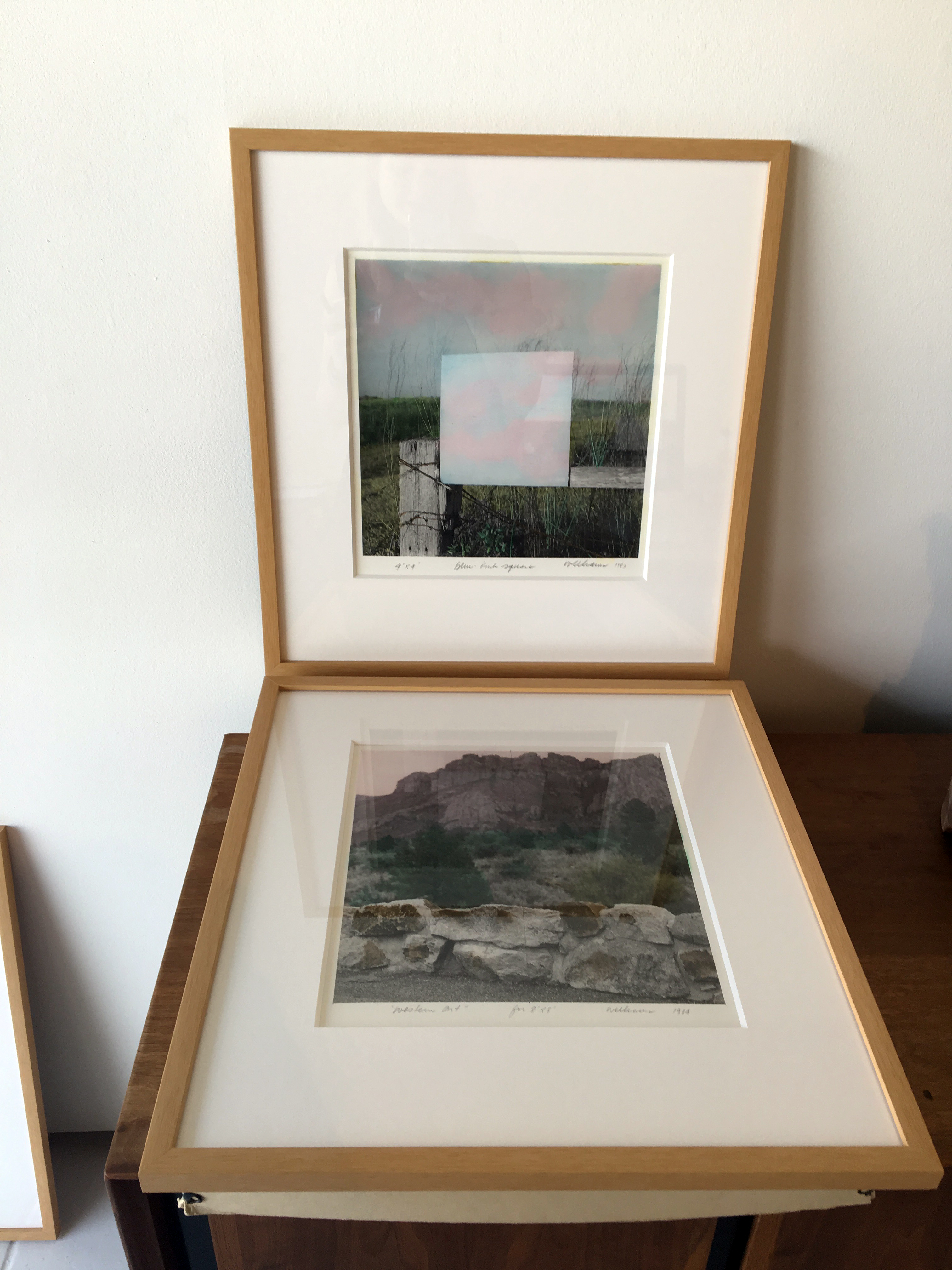
Casey Wiliams, Studies of 4 x 4 foot photographs
For Williams, expirimentaiton across all mediums and ideas is what led to his final series being known as the "painted-ons", where Williams would brush paint across his photographic images. Williams did not personally speak much about his art. However through Williams' life, it is indisputable of his love for the Houston ship channel and the influence it made on his work. Williams was particularly interested in the way a ship would float toward the surface as goods were unloaded, decreasing the ship's weight. The lower portion of the ship would then be repainted by the crewmen. The action of repainting is symbolic of Williams' paint strokes atop his own images. Many of the strokes are colors of blues and silvers, further symbolizing the shimmer and reflection of water and possibly an ode to his earlier silkscreen works, as well as becoming a meditative process for Williams.
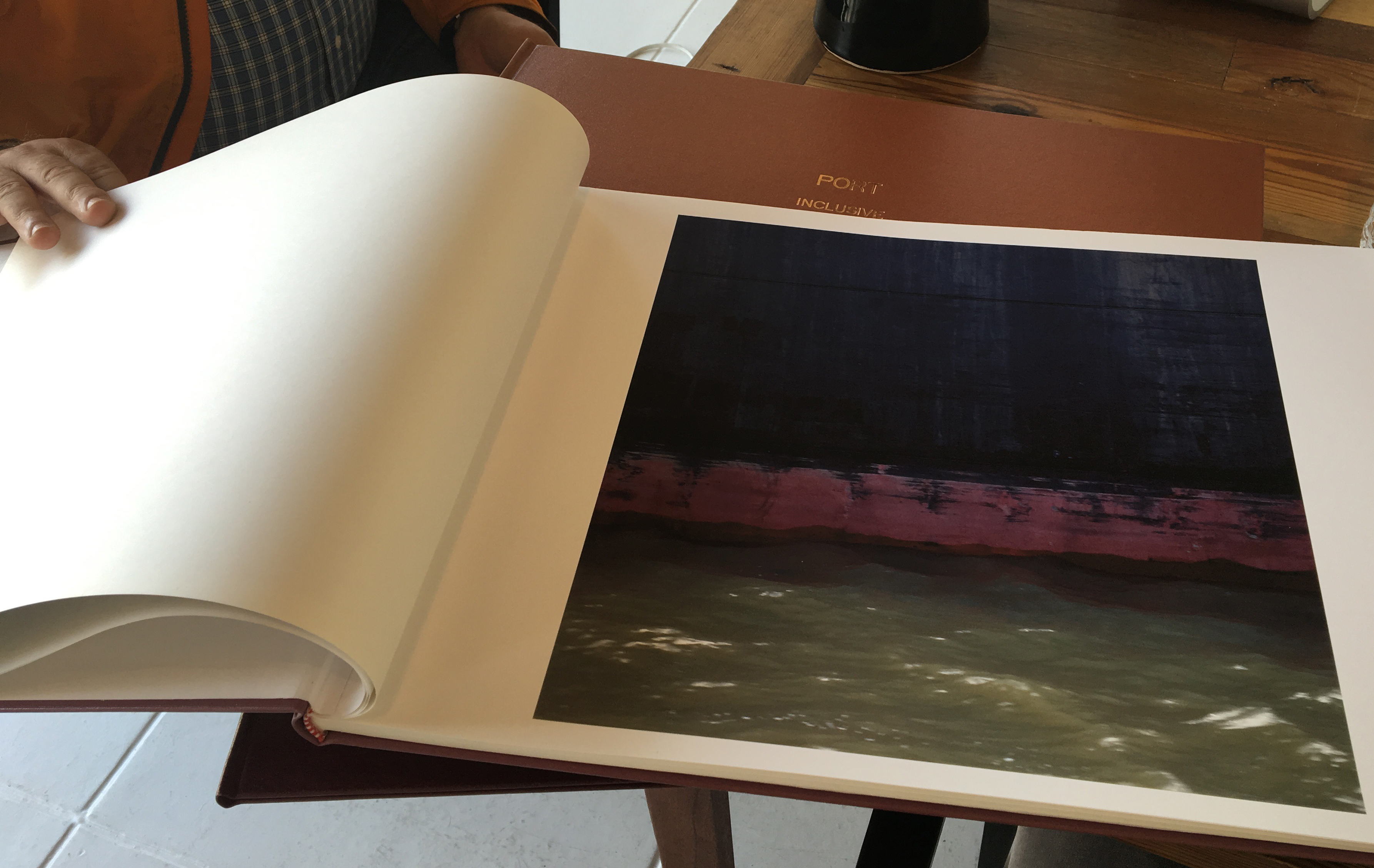
Book compiled of photography by Casey Wiliams
Casey Williams noticed details that many would naturally overlook. He forced the viewer to go somewhere they would normally bypass, giving a new perspective to the world. Williams was a master at opening up our eyes to beauty.
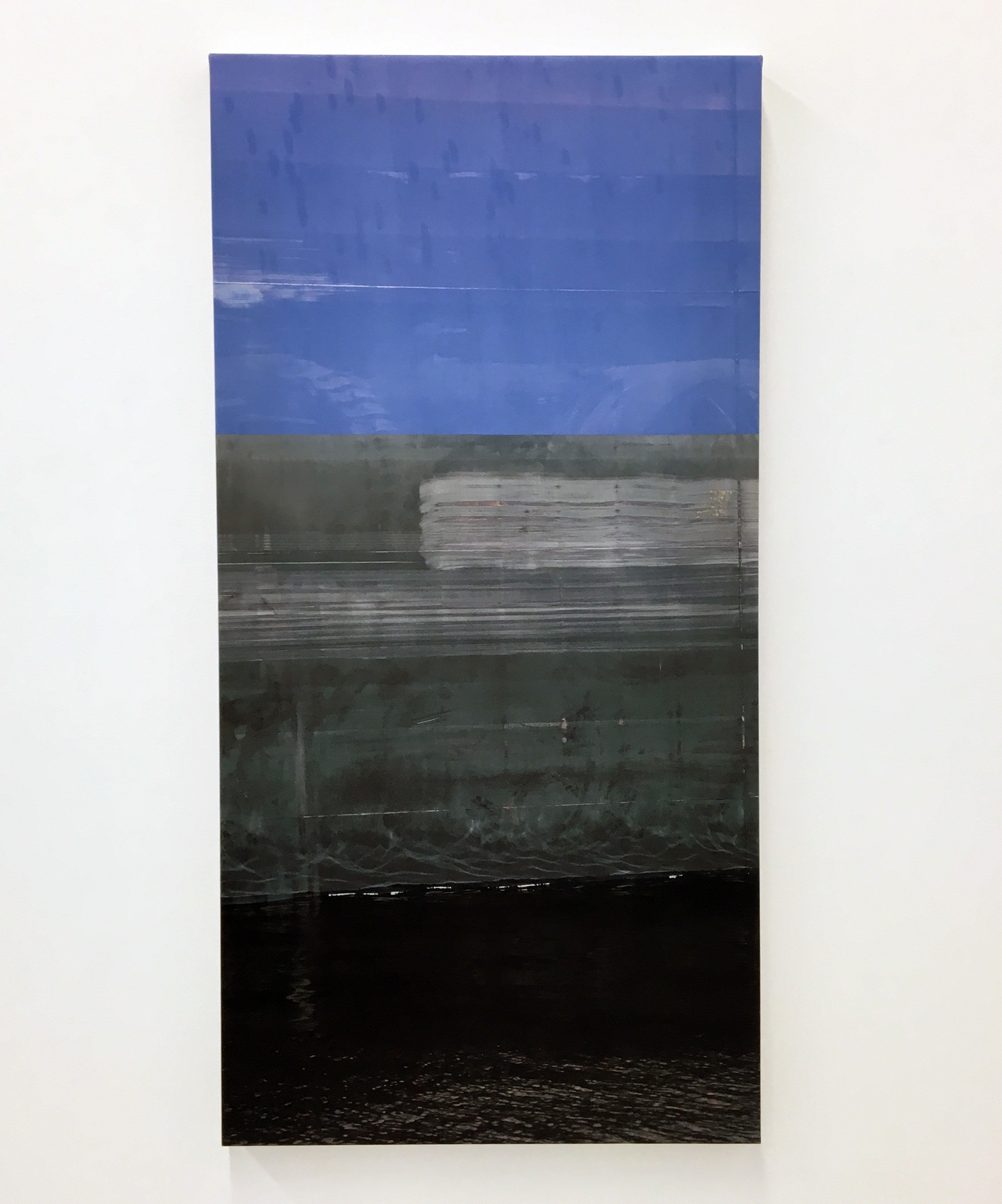
Casey Williams, Untitled, c. 2012, acrylic on archival inkjet print on satin. Exhibited at Art Palace Gallery. 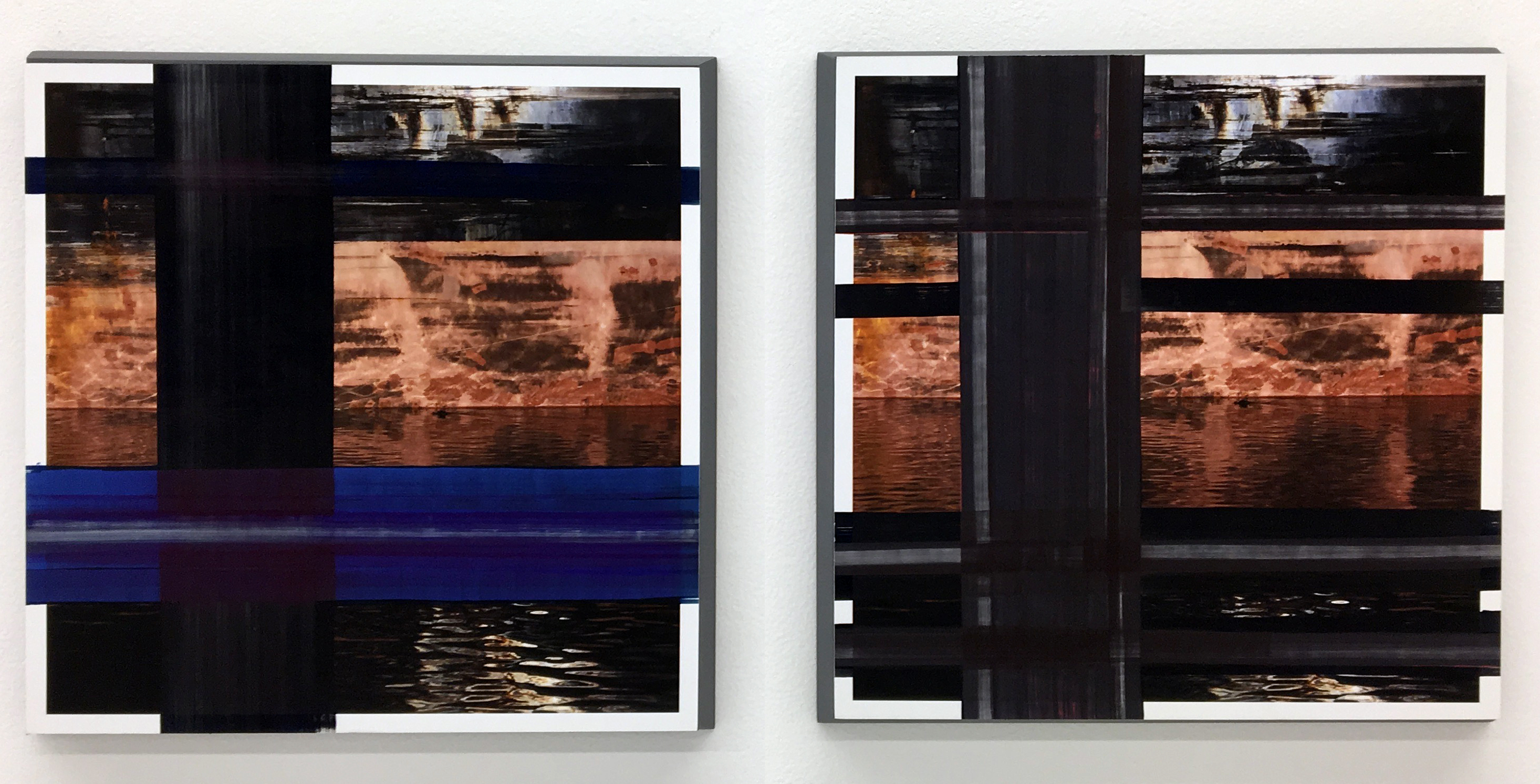
Casey Williams, Untitled & Untitled, c. 2012, acrylic on archivsl inkject print. Exhibited at Art Palace Gallery.
We first discovered artist, Yamini Nayer, at a presigious art fair last year. Brooklyn based, Nayar, has been on our radar since, and we recently had the pleasure of doing an interview with her! Check it out now on our Let's Talk Art Interview below to see what her art process is all about.
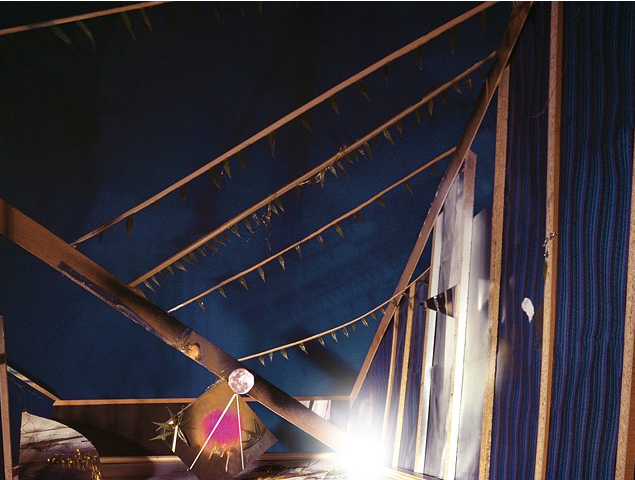
Yamini Nayar, Strange Event, 2015, photograph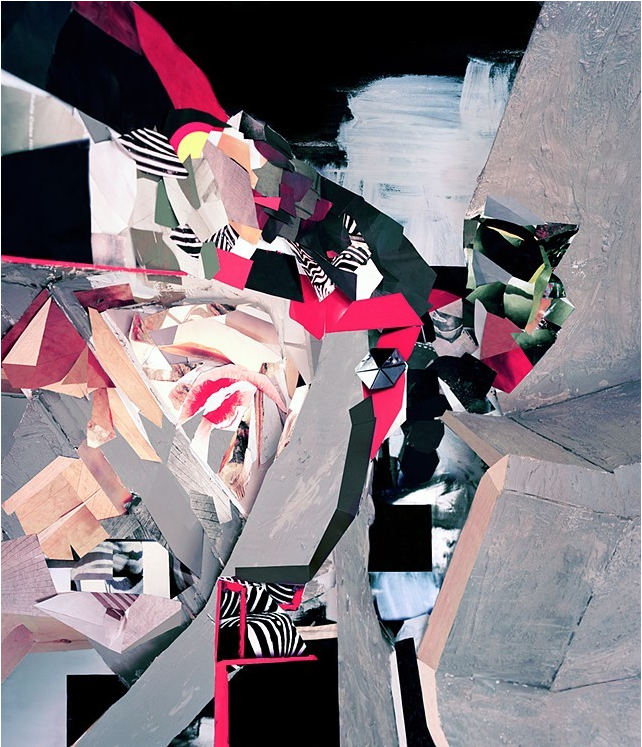
Yamini Nayar, Garden for Laborers, 2015, photograph

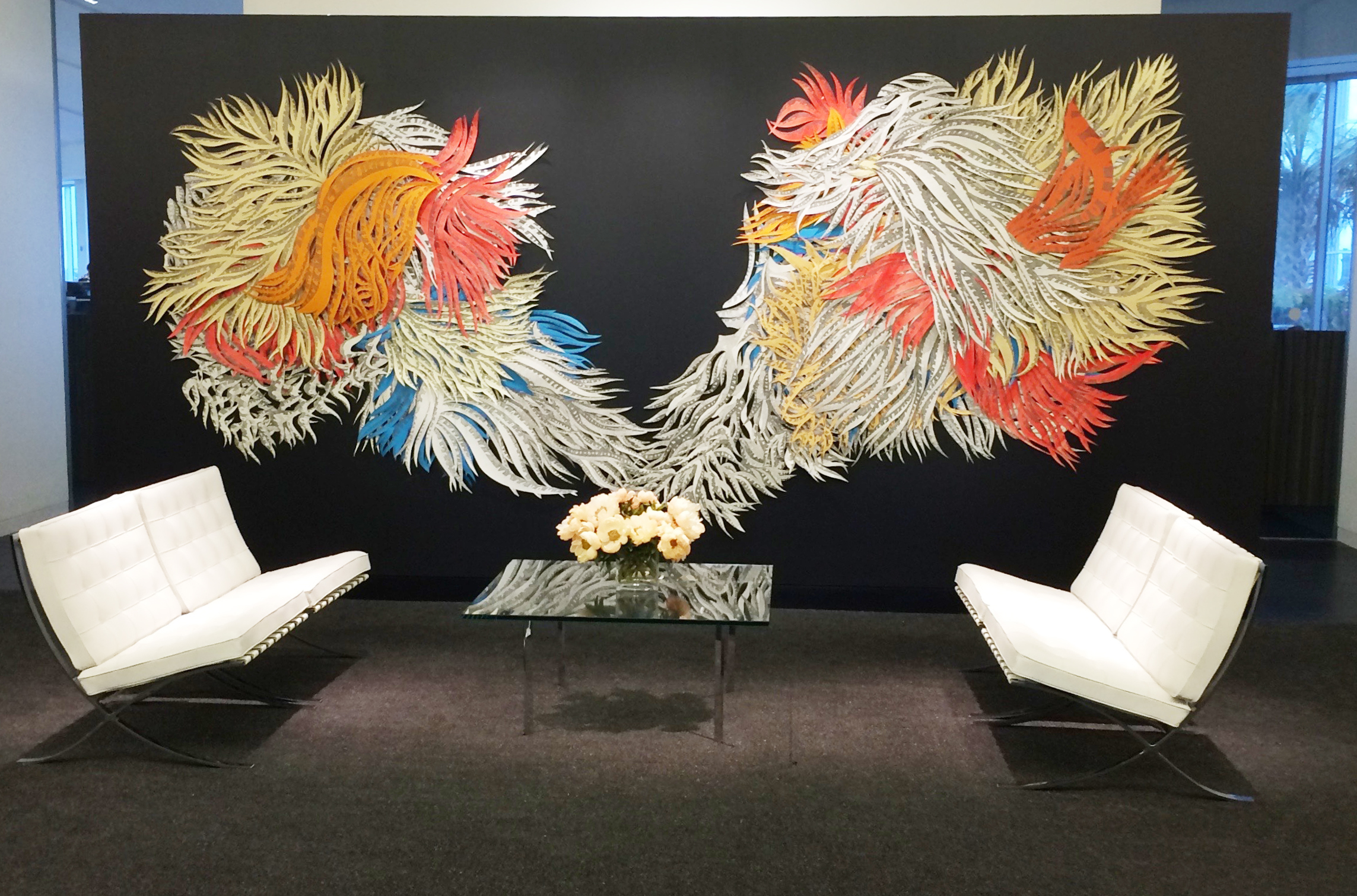
Kinzelman Art Consulting recently organized a temporary exhibition with Houston based artist Natasha Bowdoin at HOK Architect’s crisp and beautiful new space. Bowdoin’s The Daisy Argument Revised is a striking and dynamic spray of feathered elements that recall the aquatic flora of her native Maine. She has installed many iterations of this layered cut paper piece over the years, the first being in 2010.
Professor of Painting and Drawing at Rice University, Bowdoin is known for her painstakingly detailed cut paper installations and collages. Process and content are equally important to Bowdoin in her work. She spends hours hand-cutting the paper elements in direct and visceral response to the even more labor-intensive drawings and transcriptions of significant literary texts. Here the artist has fluidly recorded the text of Lewis Carroll’s Alice’s Adventures in Wonderland and portions of Through the Looking-Glass throughout the abstract composition of the piece.
Natasha Bowdoin’s The Daisy Argument Revised will be on view at HOK through mid-December, 2015.
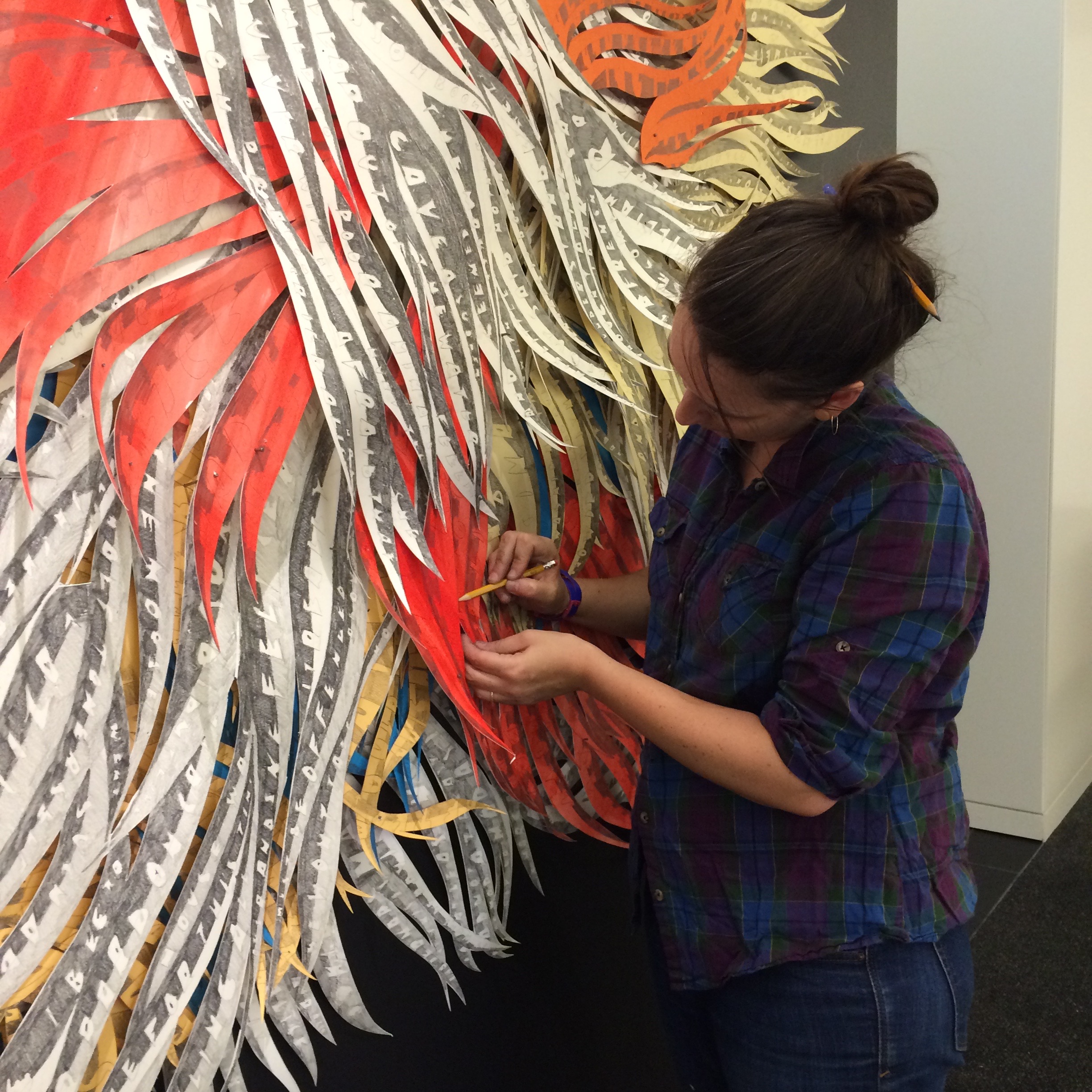
During the installation process, where Natasha intuitively attached individual elements to HOK’s feature reception wall, KAC’s Adrienne Johnson had a conversation with the artist about the piece and about her work in general.
Q: What was the first text you transcribed?
A: Alice’s Adventures in Wonderland. Before, when I first started to use writing in my work it was much more fragmentary. I would transcribe clips of overheard conversation, portions of remembered song lyrics, and bits of my own stream of conscious writing: things that were floating around the studio as I worked. My work is now made up of other authors’ texts. I was drawn to the idea of using others’ writing as a kind of found, raw material, in that it introduced an element into the work and process that wasn’t personal to me and wasn’t something I could predict. This particular piece includes transcriptions of the entirety of Alice’s Adventures in Wonderland, and a portion of Through the Looking-Glass.
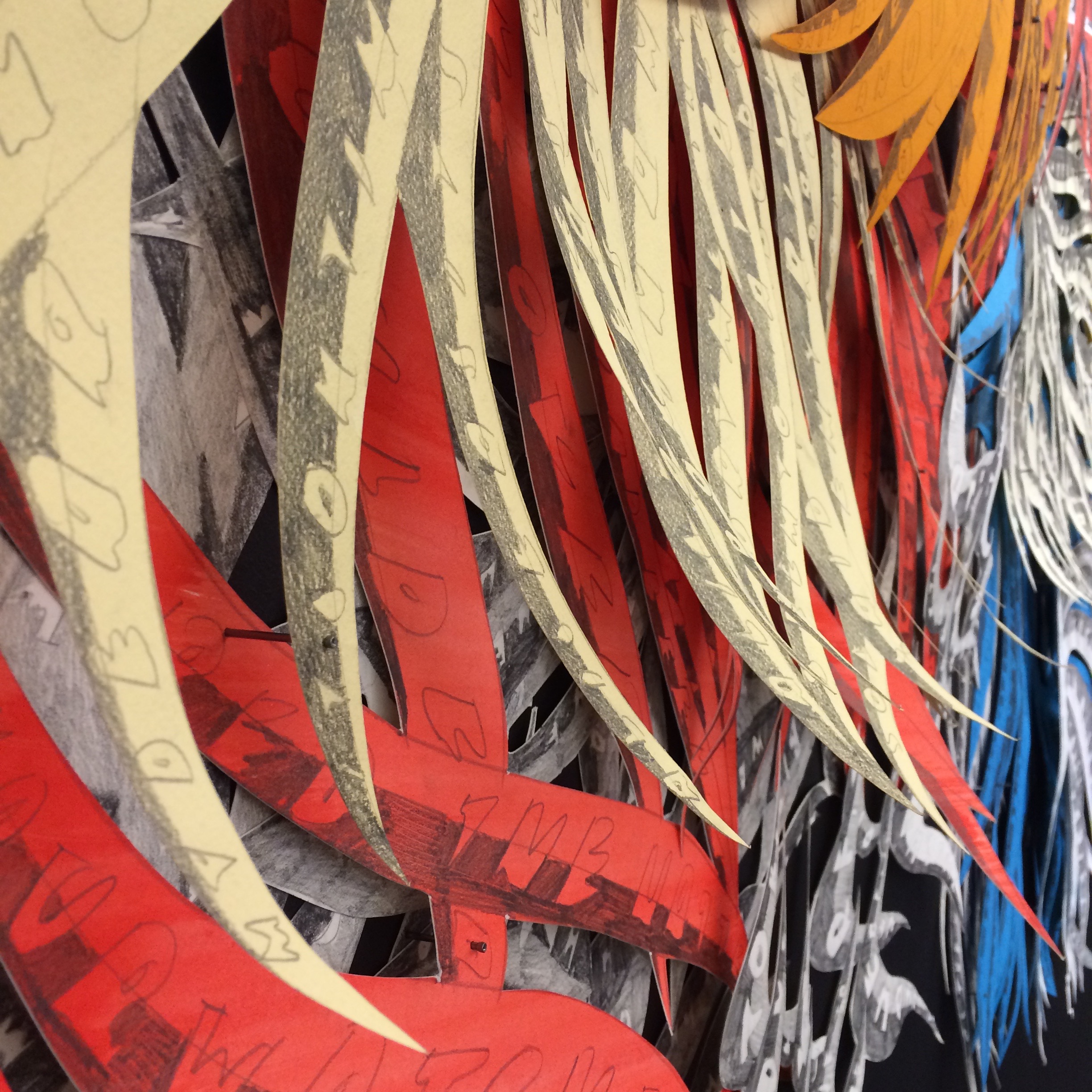
Q: How long does it take you to make a piece like this, in its original iteration?
A: This piece in my mind will never be finished. Firstly, I want to complete the transcription of Carroll’s second Alice book. As I mentioned before, I have only partially completed Through the Looking-Glass. Secondly, while at some point the drawings and component parts will be complete, I see this piece staying in flux and transition, resisting any one finite form. The piece is intuitively recombined in each new space it comes to inhabit, never going together the same way twice. Each installation is to a certain extent improvisational. Drawings for a particular installation are usually in the making for several years, as I tend to work on a lot of different pieces at once. If I sat down and focused solely on one installation alone it would come together faster but I like splitting my attention across different works and projects in the studio, in the hopes that different pieces might influence one another in a way I can’t predict.
Q: Is it your intention that viewers read your works?
A: I hope people are neither prevented from reading the work nor feel obligated to. I’m not particularly interested in using text as a means to directly articulate a message or illustrate a meaning. There is a tradition of text in art, established especially in certain kinds of artistic investigation that really took off in the 1960s, that focuses on text as a device for communication or a signifier of meaning. I’m more interested in and inspired by artists like León Ferrari, Robert Smithson, and Mira Schendel, who I think were really interested in the abstract potential of text. People can look for meaning in my drawings, but the structure defies any sense of logic. I don’t give anyone a specific place to begin. Text I think isn’t always straightforward, obvious, or transparent. I like channeling this room for flexibility, ambiguity, and a text’s potential.
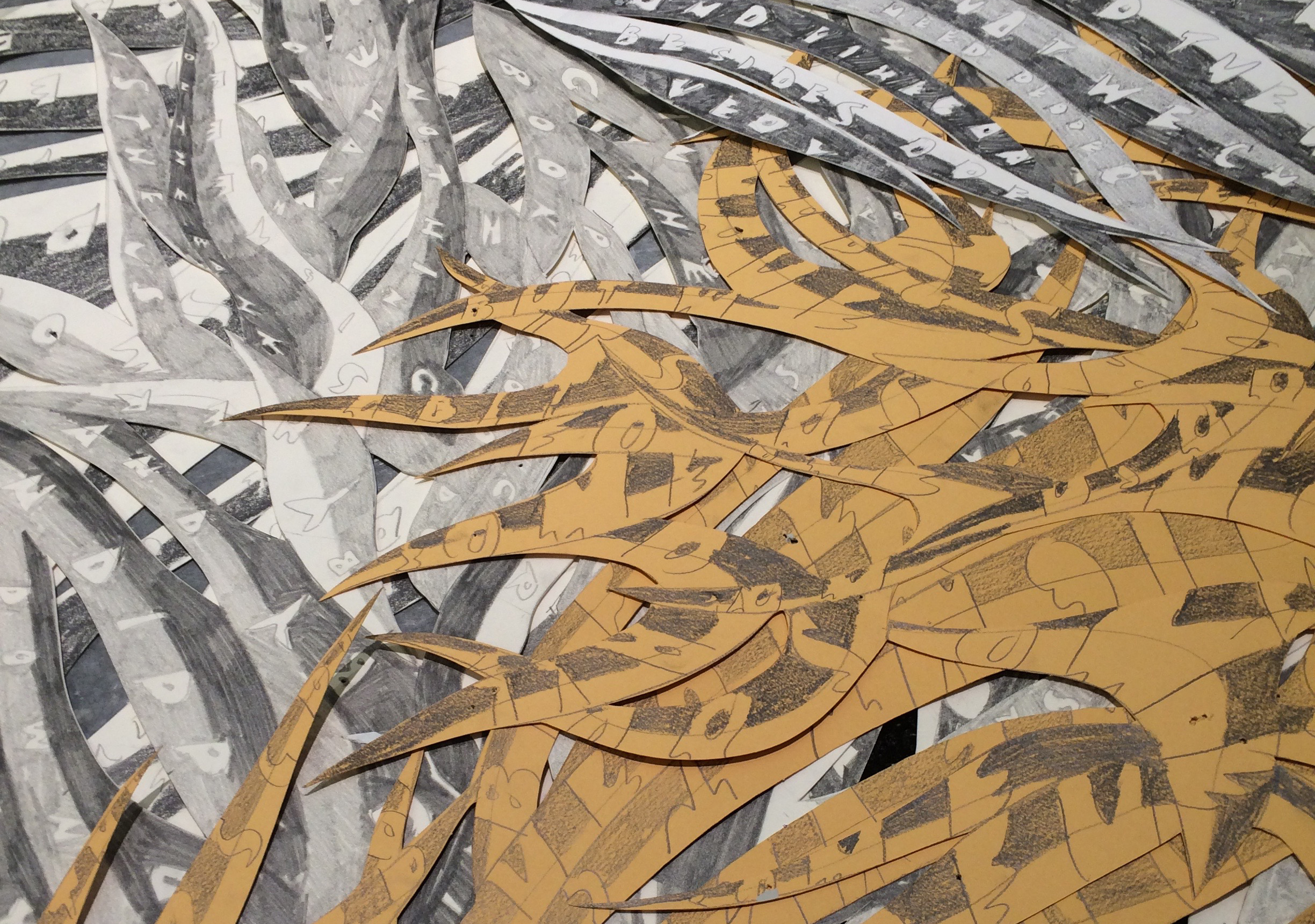
Q: Will you tell me about the inspiration for the forms themselves?
A: A lot of the pattern I gravitate towards as source material is nature based. I’m fascinated with how humans over time have tried to depict and document the world around them. With this piece, I’ve had people tell me that they are reminded of life under the sea, seaweed and sea fans for instance. These weren’t forms I intentionally had in mind but I guess it’s impossible for me to get away from where I grew up. The natural surroundings of my home state of Maine and elements of my upbringing I think work their way into my work subconsciously.
Originally this piece was kept in a palette of black, white, and yellow in that I was thinking of the color of type in a book, and of Alice’s blond hair. Eventually I began to add more and more color in an attempt to reference the wackiness and the vibrancy of Carroll’s Wonderland.
Another reason the work remains in flux is that in a way it’s meant to mirror Alice’s own experience. As she travels through Wonderland she is constantly shrinking or expanding to make her way through the space. There’s a lack of fixed boundary to her own body as she continues on her adventure. This piece is meant to evoke that sense of boundarylessness I find so appealing.
See the installation time-lapse video here:




